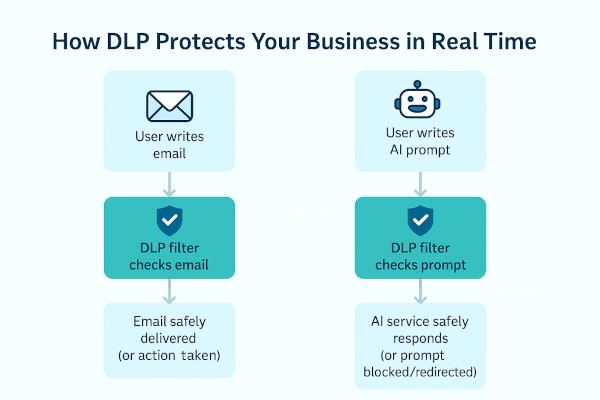Mistakes happen. Even in companies with strong cybersecurity measures, human error can lead to accidental data leaks. That’s why implementing Data Loss Prevention (DLP) is so critical to a strong cybersecurity strategy.
Most data breaches aren’t caused by hackers breaking through firewalls at 3 a.m.
They’re caused by ordinary people making everyday mistakes — like sending the wrong attachment or pasting confidential client notes into an AI tool without thinking twice.
That’s where Data Loss Prevention (DLP) steps in.
DLP isn’t a silver bullet. It’s a smart layer of protection that catches mistakes before they turn into major security incidents.
What is Data Loss Prevention (DLP)?
Data Loss Prevention (DLP) is a cybersecurity technology that monitors sensitive information and prevents it from being accidentally shared, leaked, or mishandled.
Think of it as a smart safety net.
DLP scans for sensitive data like social security numbers, financial information, or client records — and can automatically block, quarantine, encrypt, or alert based on your company’s policies.
DLP doesn’t replace essential cybersecurity tools like firewalls, antivirus, or employee training.
It complements them, protecting data when human behavior, not technology, creates risk.

The Flexibility of DLP: Protecting Data Your Way
One of the biggest strengths of Data Loss Prevention is its flexibility.
When a rule is triggered — for example, if an email contains sensitive information — DLP can take different actions depending on what leadership and the security team decide is appropriate.
- Blocking the email or message entirely
- Quarantining it and alerting the sender
- Notifying a manager for review
- Automatically encrypting the communication and allowing it to proceed
The goal isn’t just to stop data movement — it’s to protect sensitive information while keeping your business operations running smoothly.
For AI platforms, DLP can block a prompt completely, notify leadership, or securely redirect sensitive requests to a private hosted AI.
Smart DLP solutions are designed to support your business, not slow it down.
The Role of AI in DLP
Older DLP systems often rely on pattern matching — looking for things like credit card numbers, social security numbers, or other specific sequences of data.
While that works well in many cases, it’s not perfect. Sensitive information can slip through if it doesn’t fit a known pattern exactly.
Modern Data Loss Prevention solutions, including the AI-driven systems we’re developing at Allstate Computers, go further.
We use smaller, specialized AI models to intelligently review content, understand context, and catch sensitive information that traditional methods might miss.
The result?
More accurate protection, fewer false alarms, and a smarter way to safeguard sensitive data in today’s AI-driven world.
Why Data Loss Prevention Matters (Even When Everything Else is Working)
You could have the latest antivirus software, hardened firewalls, enforced multifactor authentication, and a disciplined patch management program.
And yet, one wrong email attachment or unfiltered AI prompt could still create a breach.
That’s because most cybersecurity tools focus on keeping attackers out.
Data Loss Prevention focuses on keeping sensitive information in.
When employees make mistakes — and they will, because they’re human — DLP acts as your second set of eyes.
Real-World Mistakes That DLP Can Prevent
- Email Mishap:
A staff member accidentally sends a spreadsheet containing client social security numbers to the wrong vendor.
DLP can detect sensitive patterns and prevent the email from being sent. - ChatGPT Overshare:
An employee pastes detailed client notes into an AI tool to “get writing help,” forgetting to scrub names and account numbers.
DLP can catch sensitive data and block the upload. - Accidental Forwarding:
A forwarded email chain contains hidden attachments from months ago — including confidential contract information.
DLP can scan attachments and block risky sends before they happen. - Insider Threat:
A frustrated employee tries to download the company’s client database onto a personal USB drive.
DLP can detect and block unauthorized data transfers.
A Smart Cybersecurity Strategy Starts With a Risk Assessment
Every business is different.
A strong cybersecurity strategy should be based on a proper risk assessment — identifying your specific threats, vulnerabilities, and regulatory requirements.
For most organizations, a strong cybersecurity foundation includes:
- Firewalls and network security
- Endpoint protection and antivirus
- Patching and updates
- Multifactor authentication
- Cybersecurity awareness training
- …and other controls based on your risk profile
Data Loss Prevention strengthens that foundation by protecting sensitive information when human behavior — not just external threats — puts your business at risk.
What Happens Without DLP?
Without a Data Loss Prevention solution in place, everyday mistakes can spiral into costly problems:
- Expensive regulatory fines (HIPAA, FTC Safeguards, GDPR, etc.)
- Lawsuits from affected customers or partners
- Long-term damage to your reputation
- Loss of intellectual property and competitive advantage
And once data leaks, trying to contain it is like trying to put toothpaste back into the tube.
(You can’t.)
Real-world data breaches often occur due to human error or oversight. For example, Samsung’s data leak via ChatGPT and the University of Louisville Health data exposure — where over 40,000 patient records were compromised — highlight how the absence of effective Data Loss Prevention (DLP) measures can lead to major security incidents.
In the case of DeepSeek’s breach, where sensitive information ended up circulating on the dark web, the onus may fall on DeepSeek for failing to secure their infrastructure. But the reality is, we are all responsible for protecting our own data.
Businesses cannot rely on free, public AI systems or external platforms to be their first line of defense.
Implementing robust Data Loss Prevention strategies helps monitor and control data flows, reducing the chances of accidental leaks — giving you greater control over your organization’s most sensitive information.
How Data Loss Prevention Helps Your Business
Implementing a DLP solution helps your business:
- Protect sensitive client and company information
- Reduce legal, regulatory, and financial risks
- Maintain customer trust and loyalty
- Stay compliant with cybersecurity regulations
- Sleep better knowing accidental leaks are less likely
Good cybersecurity isn’t about buying a shiny new tool.
It’s about building smart, layered defenses — and Data Loss Prevention is one of the smartest layers you can add.
Final Thoughts
Most businesses focus on locking the front door.
Data Loss Prevention makes sure no one accidentally leaves the back door wide open.
If you’re serious about protecting your business against the risks people don’t mean to create,
let’s talk.
Contact Allstate Computers today to learn how DLP can strengthen your cybersecurity strategy.

